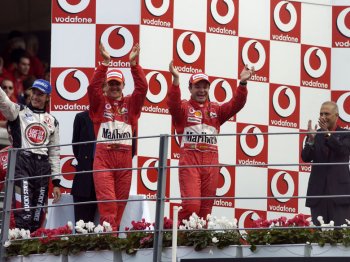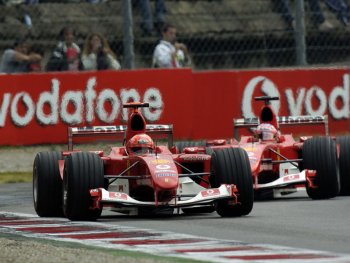|
Over the past
few years, the Italian Grand Prix weekend has been a time of
celebration for Scuderia Ferrari and a chance to say thank
you to the home fans as another season approaches its finale
with both titles already in the bag. This year the landscape
is different and Ferrari will be hoping that Monza might
signal the start of a late flourish with five races still
remaining in the championship.
However, some
aspects of Monza remain the same: the support from the
tifosi and their red flags, the atmospheric venue, the high
speed nature of the famous track and the need for minimum
downforce and maximum power, on what is the last remaining
true high-speed circuit on the calendar.
With top speed
being a key, the 055 engine in the back of the two F2005
comes under a lot of strain at this circuit with its “duty
cycle” being the highest of any track, as full throttle is
used for 70% of the lap. Both Michael Schumacher and Rubens
Barrichello have their own group of engine specialists
looking after their needs at the track and in charge of the
German’s group is Luigi Fraboni.
Born in Medicina,
Bologna in 1969, Fraboni first came into contact with
Ferrari while studying Mechanical Engineering, as he did his
thesis with the Maranello marque. “It was a great
experience, then after military service I got the chance of
a job with (automotive electronics specialists)
Magneti-Marelli in Bologna,” recalls Fraboni. “After a year,
I moved to Ferrari Gestione Sportiva in the calculations
department before switching to the design side. After three
years, I felt I wanted to do something a bit closer to the
on-track action and so I was given a position working with
our customer teams.” A two year stint with the Scuderia’s
test team followed and as of last year, Fraboni has filled
the role of Michael Schumacher’s engine engineer at the
races.
His work can be
split into two general areas: performance and reliability.
“On the one side I am specifically looking after the engine
for one driver,” says Fraboni. “On the performance front I
am looking to optimise all the engine mapping to get maximum
power, to get it to suit the specific track layout and also
the driver’s needs and driving style. We look at improving
driveability in each corner and how to make the best use of
other parameters such as torque and engine braking. We
discuss all aspects with the driver in order to optimise the
car and that is always a compromise between getting maximum
power with maximum reliability.
"Fuel consumption is another important area, as we are
always striving to consume less during the race and we have
the possibility to alter various parameters to achieve this.
The other side is reliability, particularly important this
year with the engine having to last for two races. We follow
all the telemetry data in real time, checking things such as
the temperature of the exhausts, bearings and con-rods.” By
studying the data, the engineers can make changes to the
engine management if it is felt necessary to ensure the
engine lasts for the two races. Fraboni’s work does not end
at the track, as every race weekend is effectively a further
test session for the engines and all data acquired at the
track is then analysed in depth back at the factory to help
with further development and design work.
|
 |
|
2004 Italian Grand Prix
winner Rubens Barrichello celebrates on the podium
in Monza with second placed team mate Michael
Schumacher and third placed Briton Jenson Button |
|
|
 |
|
The 2004 Italian Grand
Prix - Michael Schumcher leads team mate Rubens
Barrichello on the way to a 1-2 victory at Monza |
|
|
As we have said, this weekend’s race at Monza is very
demanding on the engine, but adding to those demands is the
fact that the engine that Rubens will use in the Italian GP
must then completed the following weekend’s Belgian event.
It will be different for Michael: after he failed to set a
qualifying time in Turkey, thus starting at the back of the
grid, the team decided to change the engine in his F2005,
which would normally mean that this same engine will be used
in Monza. . “At both these circuits, engines spend a long
time flat out at full throttle at very high revs,” confirms
Fraboni. “Therefore they are the hardest tracks. However,
Spa is located at relatively high altitude, so the
atmospheric pressure is lower and this makes it kinder on
the engines. We prepare for these races in a specific way,
doing long runs on the engine test bed before going to the
track. We have also done long runs at the Monza circuit
itself during testing, so we have a full set of data from
the track as well and from these we can plan a specific
series of strategies for this type of circuit in terms of
fuel carburetion and also the revs. Obviously Monza is a
very important track for us and we will have a new step on
the engine for Monza, which will be the last evolution for
this year.”
Even with all
the modern technology, driver feedback is still a vital
weapon in the armoury and Fraboni and his colleagues have
the advantage of working with a seven times world champion.
“Michael is very precise and therefore those of us who work
with him have to live up to his expectations,” says the
engineer. “We must pay great attention to everything,
presenting a complete rundown of all the data and obviously
this makes the work very enjoyable. From a professional
point of view it is very stimulating, as we look at every
aspect of engine together. On the human side it is
exceptional because he is very good to work with and in all
situations we have a great personal relationship. He is
never stressed which is marvellous. He is a winner on the
track, but he also has a winning personality. We can tell
from what he asks that his understanding of what the engine
does is very good. There are many things that can be changed
on an engine during a race, using three or four buttons.
During the race Michael is already changing these parameters
even before we have asked him to make any changes. He feels
when a change might be necessary. For example, as the tyres
degrade the engine characteristics can be changed to improve
driveability or there might be other changes that can be
made that are specific to individual corners."
Of course, Scuderia Ferrari runs two cars in every grand
prix and although Fraboni’s work is centred on Schumacher’s
car, he also knows exactly what is happening in the
Barrichello camp. “Just as the chassis engineers swap
information between the two cars, so too do the engine
engineers,” he confirms. “The engine group is very united
and all the information from both cars is centralised. If we
find anything on one car that is good we put it immediately
on the other car. The only exception to this rule concerns
changes that are specifically related a driver’s own style
of driving.”
|
|
|
|
![]()
![]()